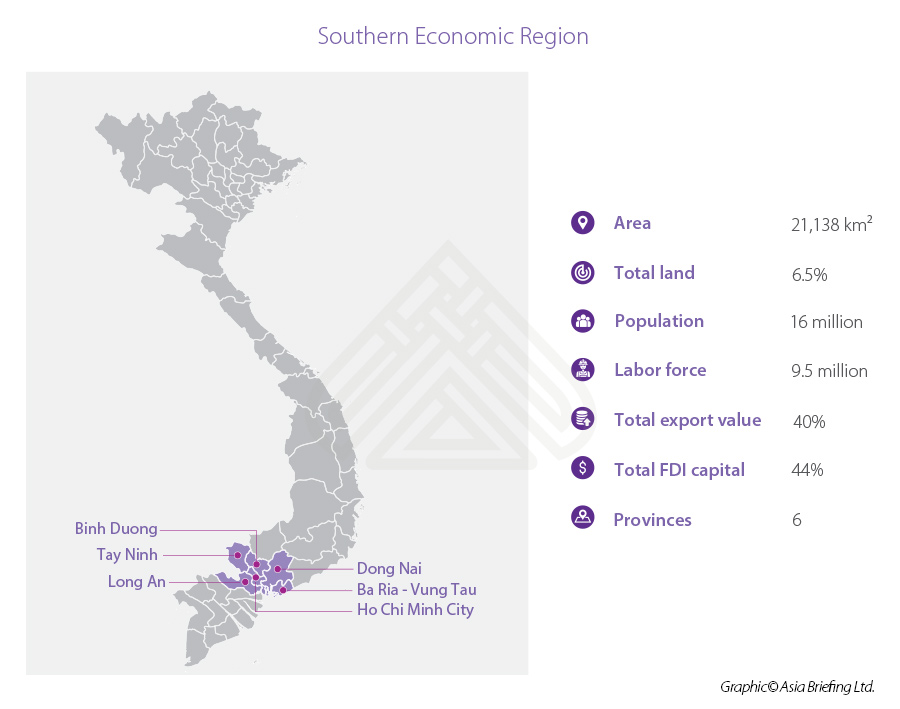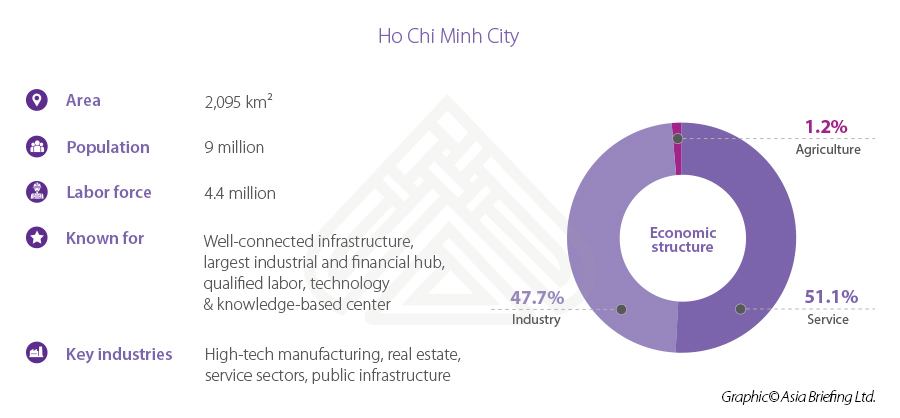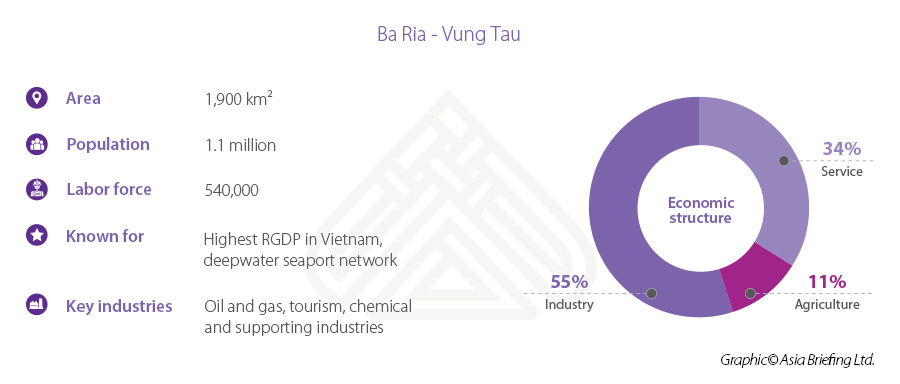Vietnam has emerged as an important investment spotlight for foreign investors. With GDP growth of 7 percent, import-export turnover of US$518 billion in 2019, and total registered capital of $362.58 billion by the end of 2019, the country continues to thrive in a wide variety of sectors. Social-political stability, a young population, a cost-competitive labor force, and government commitment to reform the regulatory framework has improved the business environment for investors in Vietnam.
The Southern Key Economic Region
Vietnam can be divided into four Key Economic Regions (KERs). These four KERs consist of the Northern, Central, Southern, and Mekong Delta regions and cover the majority of economic and investment hubs in the country.
The Southern KER is the most important center of economic activity in the country creating 40 percent of the national GDP and accounting for 42 percent of the country’s total FDI stock. This region offers a dynamic and diverse business environment welcoming for both small and medium enterprises (SMEs) and large-scale businesses, as well as the best quality of human resources in the country.
The Southern KER is a leading zone for advanced manufacturing and is encouraging investments in knowledge-based and high-tech industries and services. The key sectors include electronics, software, IT, telecom, hi-tech agriculture production, and processing, which are the primary drivers of future investment. Ho Chi Minh City, the most important financial and trading hub of the whole country, focuses on service sectors such as finance, logistics, tourism, healthcare, and education.
Although the Southern KER is the leading economic center of the country, it still lacks a holistic coordinated plan among the provinces to ensure the linkage between economic development planning and infrastructure investment.
Investors interested in the Southern KER should consider infrastructure development such as waterways, railway, and expressway construction, and optimization of land and natural resource to enhance the competitiveness of their investment.
To understand more about the Southern KER, we take a look at six economic hubs in the region primed for investment.
Ho Chi Minh City
Overview
Divided into 24 administrative district units, Ho Chi Minh City (also known as Saigon) is home to more than 9 million people, making it the largest city in Vietnam. With a strong economy supported by the most dynamic human resources in the country, the city holds the leading role in driving the economic and social development of the whole country.
Economy
Ho Chi Minh City has experienced robust growth in all economic sectors with an average annual growth of 8.3 percent in 2019. The service sector is the largest contributor to the city’s output at 57.8 percent followed by industrial production and construction. There are nearly 150,000 enterprises in the city, from startups, SMEs to big international corporations, employing approximately 2.5 million people.
Infrastructure
Ho Chi Minh City has well-developed infrastructure supporting industrial production and international trading. Cat Lai port handles more than 121 million tons of cargo annually. Tan Son Nhat International Airport is the largest airport in Vietnam serving 38 million passengers per year. Ho Chi Minh City also has excellent access to the Mekong Delta region via the HCMC – Can Tho expressway, to Vietnam’s Central region through HCMC – Dau Giay expressway, and to Cambodia through National Road No 22.
There are a total of 19 industrial zones (IZs) including three export processing zones, 14 industrial parks, and two hi-tech parks. Given the attractiveness of the location and the limited available industrial land, the local government is more focused on green, high-tech, and high value-added projects. Industrial zones in Ho Chi Minh City also have the highest leasing rates in Vietnam.
Foreign Investment
Up until 2019, Ho Chi Minh City licensed 9,173 FDI projects valued at US$47.3 billion. South Korea, Japan, and Singapore were the top three investors. Leading foreign projects include Intel (US), Samsung (South Korea), Toshiba, Isuzu, and Nidec (Japan).
In addition, Samsung has poured US$1.4 billion to build an R&D center for audio-visual devices and provide warranty services at Saigon Hi-Tech Park. Intel has invested US$1 billion in a plant for chip assembly and testing. Another significant FDI project is the US$6 billion ecological urban system, Saigon Peninsula Project, jointly invested by Malaysian and Vietnam investors.
Ba Ria Vung Tau – The oil and gas hub
Overview
Ba Ria – Vung Tau (BRVT) is a coastal province in Southern Vietnam. It shares borders with Ho Chi Minh City, Dong Nai and Binh Thuan provinces. The province has two cities and six districts with a population of approximately 1.1 million.
Economy
BRVT is the hub of oil and gas and related services in Vietnam. It also hosts a strong metalworking and machinery industry linked to the shipping and oil industry. With most of the revenue coming from this industry, BRVT has the highest Real Gross Domestic Product (RGDP) per capita in Vietnam. However, due to the recent downturn of the oil industry, the province has shifted its focus to seaports and logistics services.
In addition, tourism is another key contributor to the provincial budget. With over 300-km of coastline and well-known beaches such as Bai Truoc, Bai Sau, Long Hai, Ho Tram, and Ho Coc, the province is one of the main tourist destinations in Southern Vietnam, attracting around 15 million visitors every year. In 2019, the provincial GDP grew 7.65 percent while industrial output increased 8.89 percent.
Infrastructure
The HCMC – Long Thanh – Dau Giay expressway and National Highway 51 has shortened the distance between BRVT and other Southern provinces. It takes only one and a half hours to travel from Ho Chi Minh City to BRVT – a distance of 125 km.
The port system in BRVT serves as an international transshipment gateway in the Southern area and can accommodate vessels up to 200,000 deadweight tonnage (DWT). There are 28 operating ports in the area with a total capacity of 98 million tons per year. Goods from Cai Mep-Thi Vai ports in this area can be shipped directly to Northern America and Europe.
There are 15 industrial zones in BRVT with total industrial land of 8,510 hectares that are close to 51 highways as well as the only deep-water port in Southern Vietnam – Cai Mep – Thi Vai international port.
Foreign investment
BRVT has lured around 466 FDI projects with total registered capital of more than US$31 billion in 2019, ranked 5th in Vietnam. The US is the biggest investor country, followed by Canada, Thailand, Korea, and Japan. One of the largest investors is the Asia Coast Development Company, which developed the US$4billion Ho Tram resort project. Another remarkable FDI project is an investment of $1.1 billion in a steel plant by South Korea’s Posco. Hyosung Corporation (South Korea) has registered capital of US$1.2 billion to establish a polypropylene factory and take part in oil and gas project (LPG storage), promoted by the government.
—————————
This article is produced by Vietnam Briefing, a premium source of information for investors looking to set up and conduct business in Vietnam. The site is a publishing arm of Dezan Shira & Associates, a leading foreign investment consultancy in Asiawith over 27 years of experience assisting businesses with market entry, site selection, legal, tax, accounting, HR and payroll services throughout the region.




